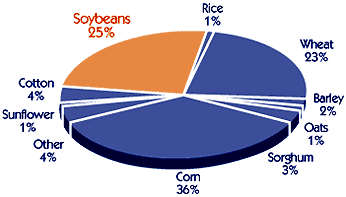The
soybean (Glycine max) is often called the miracle crop. It is the
world's foremost provider of protein and oil. The bushy, green
soybean plant is a legume related to clover, peas and alfalfa.
Farmers plant soybeans in the late spring. During the summer,
soybeans flower and produce 60-80 pods, each holding three pea-sized
beans. In the early fall, farmers harvest their crop for these beans
which are high in protein and oil. A 60-pound bushel of soybeans
yields about 48 pounds of protein-rich meal and 11 pounds of oil.
U.S. farmers planted 11.9 million fewer acres (4.9 million fewer
hectares) of soybeans in 2007 than they planted in 2006. This 15.7
percent reduction was primarily caused by an increased demand for
ethanol produced from corn. Even with this reduction in planted
soybean acres, more soybeans were grown in the United States than in
any other country in the world.
In
2007, U.S. soybean farmers harvested 2.585 billion bushels (70.36
million metric tons) of soybeans. Nearly half the total value of the
U.S. soybean crop was exported as whole soybeans, soybean meal and
soybean oil. ASA supports U.S. soybean and product export promotion
activities in more than 80 countries around the world.
As early as 5,000 years ago, farmers in China grew soybeans.
In 1804, a Yankee clipper ship brought soybeans to the U.S. When
leaving China, sailors loaded the ship with soybeans as inexpensive
ballast. When they arrived in the U.S. they dumped the soybeans to
make room for cargo.
In 1829, U.S. farmers first grew soybeans. They raised a variety for
soy sauce. During the Civil War, soldiers used soybeans as
"coffee berries" to brew "coffee" when real
coffee was scarce. In the late 1800s significant numbers of farmers
began to grow soybeans as forage for cattle.
In 1904, at the Tuskegee Institute in Tuskegee, Alabama, George
Washington Carver began studying the soybean. His discoveries
changed the way people thought about the soybean; no longer was it
just a forage crop. Now its beans provided valuable protein and oil.
By 1929, U.S. soybean production had grown to 9 million bushels.
That year, soybean pioneer William J. "Bill" Morse left on
a two-year odyssey to China during which he gathered more than
10,000 soybean varieties for U.S. researchers to study. Some of
these varieties laid the foundation for the rapid ascension of the
U.S. as the world leader in soybean production.
Prior to World War II, the United States imported 40 percent of its
edible fats and oil. At the advent of the war, this oil supply was
cut. Processors turned to soybean oil.
U.S. Crop Area
Planted 2007 |

Today, farmers in more than 30 states grow soybeans, making soybeans the United States' second largest crop in cash sales and the number 1 value crop export.
Source: USDA, does not include all hay |
|
By 1940, the U.S. soybean crop had grown to 78
million bushels harvested on 5 million acres, and the United
States was a net exporter of soybeans and soybean products. That
year, Henry Ford took an ax to a car trunk made with soybean
plastic to demonstrate its durability. The publicity increased the
soybean's popularity.
In the early '50s soybean meal became available as a low-cost,
high protein feed ingredient, triggering an explosion in U.S.
livestock and poultry production.
In 1999, the year Congress passed EPACT legislation supported by
the American Soybean Association (ASA), U.S. commercial production
of renewable soy biodiesel fuel measured about 500 thousand
gallons. By 2004, soy biodiesel production had increased to 25
million gallons, and by 2007, following passage of the federal
Biodiesel Tax Incentive championed by ASA and its state
affiliates, soy biodiesel production had increased to 450 million
gallons. |
|
| Return to Soy Stats homepage |
Order a printed Soy Stats |
| Major funding for the 2008 edition of Soy StatsÒ was
provided by the United Soybean Board, with additional financial
support of the Illinois Soybean Association, Indiana Soybean Alliance,
Iowa Soybean Association, Ohio Soybean Association, South Dakota Soybean Research &
Promotion Council, North Dakota Soybean Council, the U.S. Soybean
Export Council, Minnesota Soybean Research & Promotion Council,
North Carolina Soybean Producers Association, Arkansas Soybean
Association and Texas Soybean Association. |
Soy
Stats®
is copyright © 1994-2008 The American Soybean Association. All Rights
Reserved. |
|
|